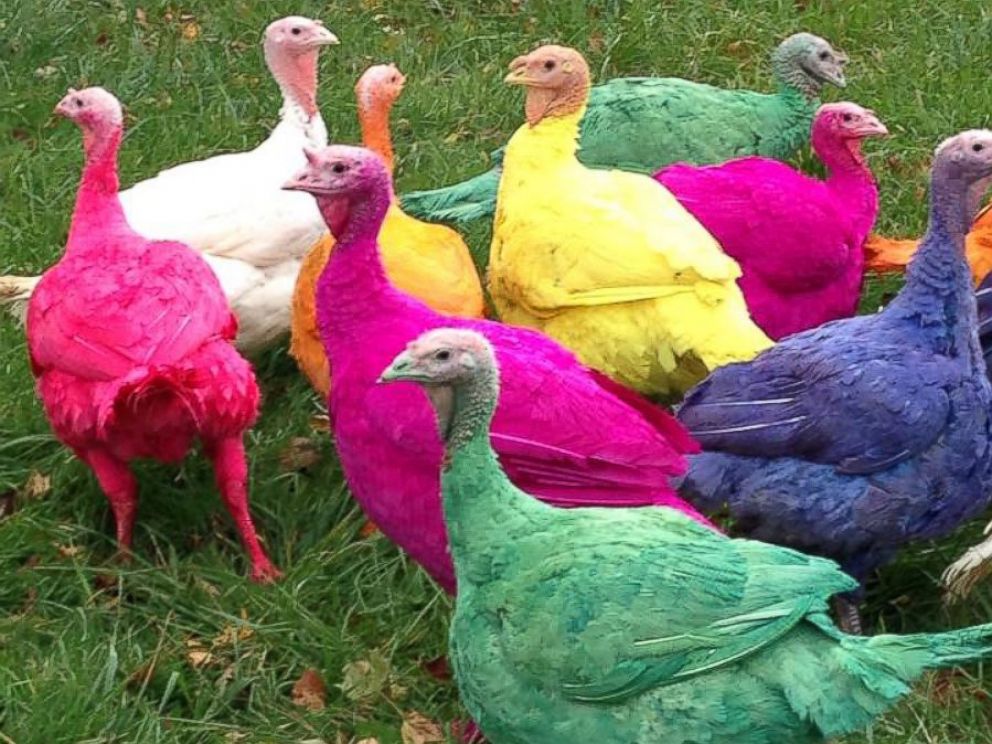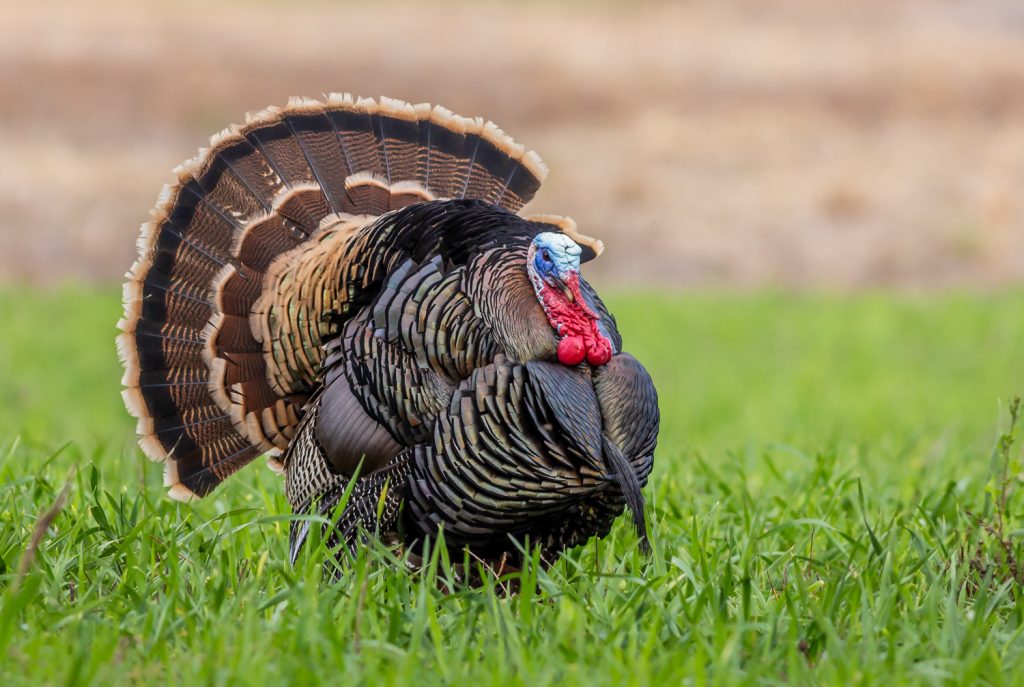Turkeys come in a beautiful array of natural colors and patterns. From the iridescent feathers of wild turkeys to the solid white birds raised on farms turkey plumage varies greatly between species, sexes, regions and breeds. Read on for a complete guide to turkey colors.
Wild Turkey Feather Colors
Wild turkeys sport gorgeous natural camouflage made up of rich earth tones. Their feathers help them blend into the forests and fields where they live. Here are the main colors found on wild turkeys
-
Dark brown is the predominant body color on wild turkeys. Their wings, back, chest and tail feathers are various shades of chocolate brown to black.
-
Bronze and copper iridescence shimmers across many of their body feathers. This results in metallic olive-brown and bronze-green hues.
-
Rusty tan appears on the tips of the tail and rump feathers.
-
Creamy white bars decorate the wings. These are visible in flight.
-
Gray to blue skin covers the head and neck. Bright red wattles dangle from the throat.
-
Iridescent green, purple and bronze show on the feathers of males during courtship displays.
The beautiful range of wild turkey feather colors and patterns provides camouflage from predators while also attracting mates.
Male vs Female Wild Turkey Colors
Male wild turkeys, also called toms or gobblers, are a bit more vibrantly colored than females of the species.
Males have more iridescent, shiny feathers with a coppery or bronze tint. Watch for a reddish-chestnut glow on the tail or wingtips of a male. Their blue head and red wattle are much more vivid than the female’s.
Females, also called hens, tend to be more subtly colored with duller brown plumage and less iridescence. Crisp white barring on the wings helps identify a female wild turkey.
Regional Variations in Wild Turkey Colors
There are subtle regional differences in wild turkey feather patterns. Turkeys in the Rocky Mountains tend to have whitish tips to the rump and tail feathers, whereas other populations have rusty or chestnut tail tips.
Some rare color morphs like smoke, red, black and white turkeys occur naturally due to genetic mutations. The smoke morph is the most common, estimated at 1 in 100 wild turkeys. These color variants can become more prevalent in certain geographical areas where the genes arise.
Domestic Turkey Feather Colors
After centuries of domestication, farm-raised turkeys look quite different from their wild cousins. Some key differences in domestic turkey coloring:
-
Most domestic turkeys are solid white. This is intentional for easier processing.
-
Some may be dark brown or black. Heritage breed turkeys show more natural coloring.
-
Iridescent feathers are less common since they are bred for meat production.
-
Bright red wattles and head caruncles are exaggerated through breeding.
-
Blue, purple, lavender, silver, red, and spotted colors sometimes occur in backyard flocks.
-
Metallic sheens occur on some heritage breeds, like the Bronze turkey.
So while wild turkeys display a mix of natural camouflage colors, domestic turkeys are often white for practical production reasons. But diverse turkey feather patterns continue to delight backyard bird enthusiasts.
How to Identify a Tom Turkey by Color
When you spot a turkey strutting through the brush, look for these color clues to tell if it’s a male:
-
More iridescent, shiny coppery feathers
-
Reddish-chestnut glow on tail or wingtips
-
Vivid blue head and red wattle
-
Richer, darker brown and blacker feathers
Females will show duller brown plumage, white-barred wings, and a smaller gray-blue head. Subtle color differences help distinguish males from females when turkey watching.
What Causes the Color Variations in Turkeys?
The different combinations of genes that a turkey can have result in the diverse colors we see. The most common turkey colors are white, brown, and black. However, there are also turkeys that are blue, red, buff, and even spotted.
These unique color variations, many stemming from recessive genes, turn up unexpectedly in backyard flocks. So while most wild turkeys are brown for camouflage, and domestic turkeys are white for production, keep an eye out for those rare turkey feather hues!
Why Your Cooked Turkey Is Brown
While a living turkey displays a spectrum of colors from its iridescent feathers, the cooked Thanksgiving turkey we are familiar with turns a golden amber shade.
Here are some of the factors that contribute to this final color:
-
Browning reactions create a tan to brown color as turkey skin and meat proteins are altered by heat.
-
Seasonings like herbs and spices add earthy hues to the skin.
-
Brining helps retain moisture for more even browning.
-
The natural pigments in the flesh and skin develop into rich, roasted shades.
So through the magic of cooking chemistry, the diverse palette of turkey feathers transforms into the singular, mouthwatering color of a perfectly roasted bird.
From subtle sex differences to rare genetic morphs, turkey plumage provides a vibrant array of natural color variations. The iridescent feathers of the wild turkey assist camouflage and mating displays. Solid white commercial turkeys are selected for efficient production. And backyard hobbyists delight in diverse heritage breeds. No matter their origins, all turkeys display a beautiful range of colors for us to appreciate.

Florida (Osceola) wild turkey
- Dark-brown tips on tail feathers
- Mostly black wings with very small white bands
- Adult males weigh approximately 20 pounds
- Adult females weigh 8 to 12 pounds
- Long legs
- Strong gobbles
- Very long spurs
- Shorter beard-lengths than Easterns on average
- Considered the toughest species to call in

Get the 411 on each all the wild turkey species and subspecies
Wild turkeys are among the most popular game animals in the world.
There are two species of the wild turkey, the American wild turkey and the Ocellated wild turkey. The American wild turkey, which is the more common of the two is comprised of five subspecies, each displaying different physical and behavioral characteristics that define them. The Ocellated turkey is native to Central America.

- Chestnut-brown tips on tail feathers
- White and black bars on the wings
- Adult males weigh 18 to 30 pounds
- Adult females weigh 8 to 12 pounds
- Very strong gobbles (strongest gobbles of all subspecies)
- Very long beards (longest beards of all subspecies)
- Second to the Osceola in difficulty of calling in

How To Draw A Funny Turkey
FAQ
What are the different colors of turkeys?
The birds are unmistakable; their signature plump shape, bald heads, and reddish-brown plumage are well known even to casual naturalists throughout the Lower 48. But not all Wild Turkeys sport this classic chestnut look. They also come in four limited-edition colors, or morphs: smoke, red, black, and white.
What are the traditional colors of turkey?
The national colors of Turkey are red and white on its flag. In addition, turquoise, which is a part of Turkish culture, is considered one of the colors of Turkey.
What color are Eastern wild turkeys?
Gobblers are dark brown to black in color with many feathers that are iridescent, with a metallic green and bronze color. Hens are a dull grey-brown in color. During breeding season, the gobbler’s head turns various shades of red, white, and blue. Hens have duller plumage and their heads lack bright colors.
What are the colors of heritage turkeys?
More than ten different turkey breeds are classified as heritage turkeys, including the Auburn, Buff, Black, Bourbon Red, Narragansett, Royal Palm, Slate, Standard Bronze, Pied, Harvey Speckled and Midget White.
